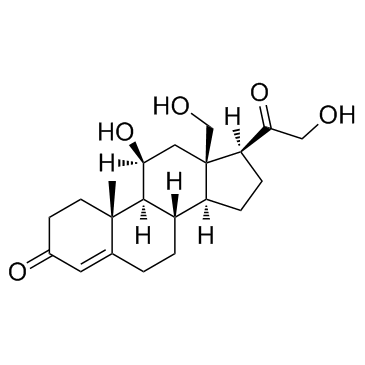Effect of chronic adrenocorticotropin stimulation on the excretion of 18-hydroxycortisol and 18-oxocortisol.
C E Gomez-Sanchez, J N Clore, H L Estep, C O Watlington
Index: J. Clin. Endocrinol. Metab. 67(2) , 322-6, (1988)
Full Text: HTML
Abstract
The human adrenal gland can metabolize cortisol to yield steroids oxygenated at the 18 position in a series of reactions similar to those by which corticosterone is converted to 18-hydroxycorticosterone and aldosterone and perhaps catalyzed by the same enzyme. These analog steroids, 18-hydroxycortisol and 18-oxocortisol, are produced in small quantities normally, but can be produced in excess by aldosterone-producing adrenal adenomas and in glucocorticoid-suppressible aldosteronism. Chronic ACTH administration has been reported to produce a transient increase in aldosterone production. We studied the effect of chronic ACTH administration on the excretion of aldosterone-18-oxoglucuronide and its relationship to the excretion of 18-hydroxycortisol and 18-oxocortisol. Five normal men collected 24-h urine samples for 3 control days and 5 days while receiving ACTH (40 U, im, twice daily). Urinary excretion of tetrahydrocortisol, tetrahydrocortisone, aldosterone 18-oxo-glucuronide, 18-hydroxycortisol, and 18-oxo-cortisol was measured by RIA. Urinary tetrahydrocortisol and tetrahydrocortisone excretion increased 7- to 10-fold during ACTH administration. Urinary aldosterone 18-oxoglucuronide excretion increased to a peak on the second day (6-fold increase) and decreased to basal levels by the fifth day of continuous ACTH administration. The excretion of 18-hydroxycortisol increased about 6-fold and remained elevated throughout the period of ACTH administration. The excretion of 18-oxocortisol increased from an average of 3.7 nmol/day to a peak of 176.7 nmol/day (a 47-fold increase) on the third day and decreased to 107.9 nmol/day on the fifth day of ACTH administration. These results are consistent with the hypothesis that the decrease in aldosterone production after 2 days of ACTH administration is the result of induction of 17-hydroxylase by ACTH, resulting in the biosynthesis of cortisol in these cells. Since the cells have the cytochrome P-450-dependent corticosterone methyl oxidase enzyme, cortisol becomes its predominant substrate, resulting in the increase in 18-hydroxycortisol and 18-oxocortisol production. We have called these cells transitional cells because they have enzymatic systems of the zona glomerulosa and the zona fasciculata.
Related Compounds
| Structure | Name/CAS No. | Molecular Formula | Articles |
|---|---|---|---|
 |
18-Hydroxycorticosterone
CAS:561-65-9 |
C21H30O5 |
|
Synthesis, biological evaluation, and molecular modeling of ...
2010-02-25 [J. Med. Chem. 53 , 1712-25, (2010)] |
|
["High pouch output" syndrome. Role of mineralocorticoid dia...
2001-12-01 [Chirurg. 72(12) , 1446-52, (2001)] |
|
Dose-dependence of the effects of corticosterone and the non...
1998-01-01 [Endocr. Res. 24(3-4) , 601-5, (1998)] |
|
[18-Hydroxycorticosterone, 18-hydroxydesoxycorticosterone. W...
1990-01-01 [Ann. Endocrinol. (Paris.) 51(1) , 1-15, (1990)] |
|
Primary aldosteronism and its variants.
1998-01-01 [Cardiovasc. Res. 37(1) , 8-13, (1998)] |